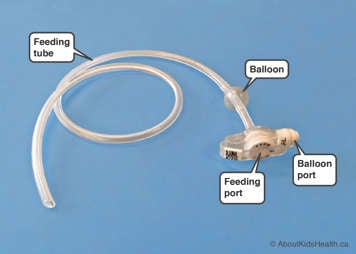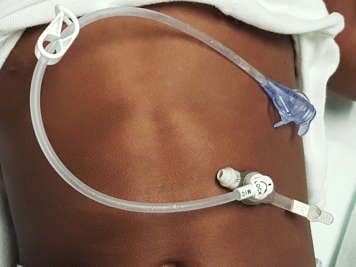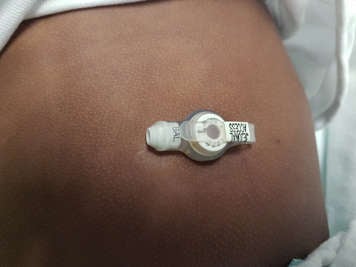
A low-profile GJ tube is a type of feeding tube that provides fluids, nutrition and medications directly to the small intestine (jejunum). It is called "low-profile" because it sits close to the skin and is very discreet. Low-profile GJ tubes are placed by an interventional radiologist using image guidance.
A Mic-Key low-profile GJ tube is not used for primary tube insertion, instead it is a transition tube. This means that your child will have had a different type of feeding tube before transitioning to the low-profile GJ tube.
The low-profile GJ tube is placed through an opening in your child's abdomen called a stoma. The tunnel from the outside through the stoma is called the tract.
| The SickKids G-Tube Feeding Program has developed a one page guide to help you quickly troubleshoot any issues with your child's feeding tube: G-Tube Feeding Program Family One Pager |
Low-profile GJ tubes are different than surgically inserted J tubes. While both are inserted into the small intestine, the low-profile GJ tube enters through your child's stomach, passes through into the first part of the small intestine and ends in the jejunum. Surgical J tubes are inserted directly into the jejunum by a surgeon in an operating room.
The G tube team provides support related to both low-profile GJ tubes and surgical J tubes after insertion.
Giving feeds, liquids and medication through the low-profile GJ tube
Your child's tube feeds are to remain the same as with previous GJ tube exchanges.
A Mic-Key low-profile GJ tube extension set needs to be attached to the feeding port to administer feeds and medications. A slip-tip syringe can be attached directly to the feeding port; however, this is not recommended as the one-way valve can break with frequent access. The one-way valve is built inside the GJ tube and prevents the stomach contents from flowing back out through the tube.
Connecting the extension set to the tube

- Open the plastic cover on the feeding tube.
- Make sure the clamp on the extension set is closed.
- Match the line on the extension to the line on the tube and push the extension into the valve.
- Holding the button tube in place, turn the extension clockwise until you feel the extension lock into place. There is an arrow on the extension to show you which direction to turn it.
- Attach your feeds, fluids and medications to the appropriate port at the end and open the clamp.
- When you have finished using the extension, flush it with water and remove it from the tube.
Removing the extension from the tube
- Clamp the extension.
- Holding the tube in place, turn the extension counter-clockwise (opposite to the arrow on the extension).
- Match the line on the extension to the line on the tube and remove the extension.
- Close the plastic cover on the feeding tube.
It is important to clean the extension set between each use and remove it from the low-profile GJ tube when it is not in use. The low-profile GJ tube's extension set should be replaced as needed (i.e. broken, rigid, stained).
Flush the tube with at least 5 to 10 mL of water before and after each tube feed and medication dose, and every 4 hours during continuous feeds to help prevent the tube from becoming blocked. To ensure this flush volume is safe for your child, discuss with your child's health-care team. You may use pancreatic enzymes to unblock a low-profile GJ tube. This can be done at home.
For more information on what to do if your child's low-profile GJ tube is blocked, please see "What to do if your child's feeding tube is blocked".
Caring for your child's low-profile GJ tube

The balloon port of your child's low-profile GJ tube helps to keep the tube from accidentally being pulled out. The balloon of a 14 French (FR)-size low-profile GJ tube can safely hold 5-10 mL of sterile or distilled water.
Here are some things to remember when caring for your child's low-profile GJ tube:
- Do not feed your child through the balloon port.
- Do not fill the balloon with saline or air.
- Filling the balloon with more or less water can affect the position of the tube.
- Less water makes the tube stick out and more water brings the tube closer to the skin.
The doctor who inserts the tube may fill the balloon with less than the recommended balloon volume. If this is the case, you will need guidance from your health-care team before you increase the balloon volume.
Filling the balloon with more or less water can affect the fit of the tube to the skin. Less water in the balloon makes the tube sit looser and stick out from the skin. More water in the balloon makes the tube sit tighter and closer to the skin. If the tube is so tight you can see an indent in your child’s skin, you can decrease the amount of water in the balloon. If the tube sticks out too much and is dangling from the stoma, you can increase the amount of water in the balloon. If adjusting the balloon volume does not help with the fit of your child’s tube, you may need to have the tract re-measured by your G tube specialist.
Checking the volume of water in the balloon
It is important to check the amount of water in the balloon at least once a week. Use a 5 mL slip-tip syringe to do this.
- Insert a 5 mL syringe into the low-profile GJ tube's balloon port (marked "BAL" on a Mic-Key GJ tube).
- Remove all the water from the balloon. Throw the removed water away - do not reuse it. It is normal for the removed water to be discoloured. You may re-use the syringe as long as you wash it well with hot water and soap.
- Re-inflate the amount of new sterile or distilled water you usually use to inflate the balloon.
It is normal to remove 0.5 mL less water from the balloon than you originally put in. This is because some of the water has evaporated.
If there is no water after attempting to withdraw, re-inflate the balloon with 5mL of water. After three to four hours, attempt to withdraw this water:
- If you get all the water back, the balloon may simply have been empty before. You can then re-inflate the balloon with the amount of water you normally put in. Check the balloon volume every two to three days to make sure there are no further problems.
- If you do not get any water back when you withdraw after three to four hours, the balloon is likely damaged and the tube will need to be replaced.
If you are concerned that the balloon is broken, there is a risk that the tube may be accidentally pulled out. Tape the tube in place until the tube can be changed in a radiology department. Meanwhile, the tube is still in place so you can continue to use the tube for feeding and medications. There is no need to go the emergency department if the balloon is broken.
Skin care
Keep the stoma and surrounding skin as dry and clean as possible. Dressings and tape are not needed with a low-profile GJ tube.
Despite your best effort to keep your child's skin around the stoma healthy, some common skin problems may occur including:
When to seek medical attention
Contact the G tube specialist if you notice any of the following signs and symptoms:
- Your child's stoma site appears infected with redness, edema (swelling) and odorous discharge.
- There is hypergranulation tissue, which is pink to bright red, bloody, raw, moist, oozing yellow sticky discharge and/or painful.
- The stoma site is leaking intestinal or stomach contents and /or formula.
- Your child experiences abdominal pain, distension, discomfort, vomiting and/or other signs of feeding intolerance.
- Your child has signs of respiratory distress (i.e. higher breathing rate or difficulty breathing).
- The tube appears to be damaged, broken, or dislodged.
If the tube has moved into the stomach
If the Mic-Key low-profile GJ tube has moved out of the small intestine and into the stomach, your child may experience:
- increased vomiting
- vomiting formula
- gagging and retching
- abdominal discomfort or pain
- bloated stomach
- diarrhea
- leaking of formula from the stoma
The position of the tip of GJ tube will need to be confirmed by an interventional radiologist using image guidance. Do not use the tube for feeding until the tube position is confirmed.
Intussusception
Intussusception may occur around the tube. Intussusception refers to when one part of the small bowel slides into the next part. This may lead to a bowel obstruction at the tip of the GJ tube. Large GJ tubes and/or normal movements of the bowels may cause intussusception.
A child with intussusception will experience:
- discomfort and feeding intolerance (vomiting when fed)
- vomiting bile (green fluid)
- diarrhea or blood in the stool
If your child’s tube has intussuscepted, contact your G tube specialist during business hours. After hours, on weekends or on holidays, take your child to the Emergency Department.
At SickKids
If your child is a SickKids patient, contact the G Tube Resource Nurse with any concerns.
G Tube Resource Nurse contact info:
Phone 416-813-7177
g.tubenurse@sickkids.ca
On weekends/afterhours, you may need to come to the Emergency Department for an alternate method of feed/fluids/medication administration.